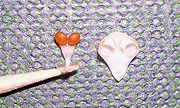.gif)
Stipe (botany)
Encyclopedia

Botany
Botany, plant science, or plant biology is a branch of biology that involves the scientific study of plant life. Traditionally, botany also included the study of fungi, algae and viruses...
, a stipe is a stalk that supports some other structure. The precise meaning is different depending on which taxonomic group is being described.
In the case of fern
Fern
A fern is any one of a group of about 12,000 species of plants belonging to the botanical group known as Pteridophyta. Unlike mosses, they have xylem and phloem . They have stems, leaves, and roots like other vascular plants...
s, the stipe is only the petiole
Petiole (botany)
In botany, the petiole is the stalk attaching the leaf blade to the stem. The petiole usually has the same internal structure as the stem. Outgrowths appearing on each side of the petiole are called stipules. Leaves lacking a petiole are called sessile, or clasping when they partly surround the...
from the rootstock
Rootstock
A rootstock is a plant, and sometimes just the stump, which already has an established, healthy root system, used for grafting a cutting or budding from another plant. The tree part being grafted onto the rootstock is usually called the scion...
to the beginning of the leaf
Leaf
A leaf is an organ of a vascular plant, as defined in botanical terms, and in particular in plant morphology. Foliage is a mass noun that refers to leaves as a feature of plants....
tissue, or lamina. The continuation of the structure within the lamina is then termed a rachis
Rachis
Rachis is a biological term for a main axis or "shaft".-In zoology:In vertebrates a rachis can refer to the series of articulated vertebrae, which encase the spinal cord. In this case the rachis usually form the supporting axis of the body and is then called the spine or vertebral column...
.
In flowering plants, the term is often used in reference to a stalk that sometimes supports a flower's ovary
Ovary (plants)
In the flowering plants, an ovary is a part of the female reproductive organ of the flower or gynoecium. Specifically, it is the part of the pistil which holds the ovule and is located above or below or at the point of connection with the base of the petals and sepals...
. In orchids, the stipe or caudicle is the stalk-like support of the pollinia
Pollinium
Pollinium, or plural pollinia, is a coherent mass of pollen grains in a plant.They are the product of only one anther, but are transferred, during pollination, as a single unit. This is regularly seen in plants such as orchids and many species of milkweeds .Most orchids have waxy pollinia...
. It is a non-viscid band or strap connecting the pollinia with the viscidium (the viscid part of the rostellum
Rostellum
The rostellum is a projecting part of the column in Orchidaceae flowers, and separates the male stamen from the female gynoecium, commonly preventing self-fertilisation...
or beak).


A stipe is also a structure found in a number of organisms that are studied by botanists but that are no longer classified as plants. It may be the stem-like part of the thallus
Thallus (tissue)
Thallus, from Latinized Greek θαλλός , meaning a green shoot or twig, is the undifferentiated vegetative tissue of some organisms in diverse groups such as algae, fungus, some liverworts, lichens, and the Myxogastria. Many of these organisms were previously known as the thallophytes, a polyphyletic...
of a mushroom
Mushroom
A mushroom is the fleshy, spore-bearing fruiting body of a fungus, typically produced above ground on soil or on its food source. The standard for the name "mushroom" is the cultivated white button mushroom, Agaricus bisporus; hence the word "mushroom" is most often applied to those fungi that...
or a seaweed
Seaweed
Seaweed is a loose, colloquial term encompassing macroscopic, multicellular, benthic marine algae. The term includes some members of the red, brown and green algae...
, and is particularly common among brown algae
Brown algae
The Phaeophyceae or brown algae , is a large group of mostly marine multicellular algae, including many seaweeds of colder Northern Hemisphere waters. They play an important role in marine environments, both as food and for the habitats they form...
such as kelp
Kelp
Kelps are large seaweeds belonging to the brown algae in the order Laminariales. There are about 30 different genera....
. The stipe of a kelp often contains a central region of cells that, like the phloem
Phloem
In vascular plants, phloem is the living tissue that carries organic nutrients , in particular, glucose, a sugar, to all parts of the plant where needed. In trees, the phloem is the innermost layer of the bark, hence the name, derived from the Greek word "bark"...
of vascular plants, serves to transport nutrients within the alga.
See also
- Stipe (mycology)Stipe (mycology)thumb|150px|right|Diagram of a [[basidiomycete]] stipe with an [[annulus |annulus]] and [[volva |volva]]In mycology a stipe refers to the stem or stalk-like feature supporting the cap of a mushroom. Like all tissues of the mushroom other than the hymenium, the stipe is composed of sterile hyphal...
. A stipe is also the stalk supporting the fruiting body of some fungiFungusA fungus is a member of a large group of eukaryotic organisms that includes microorganisms such as yeasts and molds , as well as the more familiar mushrooms. These organisms are classified as a kingdom, Fungi, which is separate from plants, animals, and bacteria...
.

